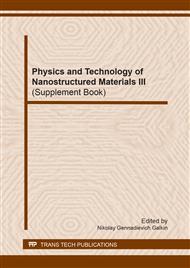[1]
D. Natelson, Nanostructures and Nanotechnology, Cambridge University Press, Cambridge (United Kingdom), 2015, 639 p.
Google Scholar
[2]
A. Krueger, Carbon materials and nanotechnology, WILEY-VCH Verlag GmbH, Weinheim (Germany), 2010, 475 p.
Google Scholar
[3]
T. Enoki, T. Ando, Physics and chemistry of graphene: graphene to nanographene, Pan Stanford Publishing Pte Ltd., Singapore / Singapore, 2013, 476 p.
Google Scholar
[4]
M. Fujita, K. Wakabayashi, K. Nakada, K. Kusakabe, Peculiar localized state at zigzag graphite edge, J. Phys. Soc. Jpn., 65 (1996) 1920-(1923).
DOI: 10.1143/jpsj.65.1920
Google Scholar
[5]
K. Nakada, M. Fujita, G. Dresselhaus, M.S. Dresselhaus, Edge state in graphene ribbons: nanometer size effect and edge shape dependence, Phys. Rev. В, 54 (1996) 17954-17961.
DOI: 10.1103/physrevb.54.17954
Google Scholar
[6]
K. Wakabayashi, M. Fujita, H. Ajiki, M. Sigrist, Electronic and magnetic properties of nanographite ribbons, Phys. Rev. B, 59 (1999) 8271-8282.
DOI: 10.1103/physrevb.59.8271
Google Scholar
[7]
A. M. Ziatdinov, Structure and properties of nanographites and their compounds, Ross. Khim. Zh. (Zh. Ross. Khim. O-va im D.I. Mendeleeva), XLVIII (2004) 5-11 [Mendeleev Chem. J. (Engl. Transl. ), XLVIII (2004), 5-11].
Google Scholar
[8]
Y. Niimi, T. Matsui, H. Kambara, K. Tagami, M. Tsukada, H. Fukuyama, Scanning tunneling microscopy and spectroscopy studies of graphite edges, Appl. Surf. Sci., 241 (2005) 43-48.
DOI: 10.1016/j.apsusc.2004.09.091
Google Scholar
[9]
Y. Kobayashi, K. Fukui, T. Enoki, K. Kusakabe, Y. Kaburagi, Observation of zigzag and armchair edges of graphite using scanning tunneling microscopy and spectroscopy, Phys. Rev. B, 71 (2005) 193406 (4 p. ).
DOI: 10.1103/physrevb.71.193406
Google Scholar
[10]
Z. Klusek, W. Kozlowski, Z. Waqar, S. Datta, J.S. Burnell-Gray, I.V. Makarenko, N.R. Gall, E.V. Rutkov, A. Ya. Tontegode, A.N. Titkov, Local electronic edge states of grapheme layer deposited on Ir(111) surface studied by STM/CITS, Appl. Surf. Sci., 252 (2005).
DOI: 10.1016/j.apsusc.2005.02.083
Google Scholar
[11]
M. Ziatdinov, S. Fujii, K. Kusakabe, M. Kiguchi, T. Mori, T. Enoki, Vizualization of electronic states on atomically smooth graphitic edges with different types of hydrogen termination, Phys. Rev. B, 87 (2013) 115427 (7 p. ).
DOI: 10.1103/physrevb.87.115427
Google Scholar
[12]
M. Ohtsuka, S. Fujii, M. Kiguchi, T. Enoki, Electronic state of oxidized nanographene edge with atomically sharp zigzag boundaries, ACS Nano, 7 (2013) 6868-6874.
DOI: 10.1021/nn402047a
Google Scholar
[13]
S. Fujii, M. Ziatdinov, M. Ohtsuka, K. Kusakabe, M. Kiguchi, T. Enoki, Role of edge geometry and chemistry in the electronic properties of graphene nanostructures, Faraday Discuss., 173 (2014) 173-199.
DOI: 10.1039/c4fd00073k
Google Scholar
[14]
M. Ziatdinov, S. Fujii, M. Ohtsuka, K. Kusakabe, M. Kiguchi, T. Mori, T. Enoki, Direct imaging of monovacancy-hydrogen complexes in a single graphitic layer, Phys. Rev. B, 89 (2014) 115405 (15 p. ).
DOI: 10.1103/physrevb.89.155405
Google Scholar
[15]
X. Zhan, O.V. Yazyev, J. Feng, L. Xie, C. Tao, Y. -C. Chen, L. Jiao, Z. Pedramrazi, A. Zettl, S.G. Louie, H. Dai, M.F. Crommie, Experimentally engineering the edge termination of graphene nanoribbons, ACS Nano, 7 (2013) 198-202.
DOI: 10.1021/nn303730v
Google Scholar
[16]
L. Talirz, H. Sode, J. Cai, P. Ruffiex, S. Blankenburg, R. Jafaar, R. Berger, X. Feng, K. Mullen, D. Passerone, R. Fasel, C.A. Pignedoli, Termini of bottom-up fabricated graphene nanoribbons, J. Am. Chem. Soc., 135 (2013) 2060-(2063).
DOI: 10.1021/ja311099k
Google Scholar
[17]
A. M. Ziatdinov, Nanographites, their compounds and film structures, Russ. Chem. Bull., Int. Ed., 64 (2015) 1-14.
DOI: 10.1007/s11172-015-0812-y
Google Scholar
[18]
Y. -W. Son, M. L. Cohen, and S. G. Louie, Half-metallic graphene nanoribbons, Nature, 444 (2006) 347-349.
DOI: 10.1038/nature05180
Google Scholar
[19]
O. V. Yazyev and M. I. Katsnelson, Magnetic correlations at graphene edges: basis for novel spintronics devices, Phys. Rev. Lett., 100 (2008) 047209 (5 p. ).
DOI: 10.1103/physrevlett.100.047209
Google Scholar
[20]
K. Sasaki, J. Jiang, R. Saito, S. Onari, Y. Tanaka, Theory of superconductivity of carbon nanotubes and graphene, J. Phys. Soc. Jpn., 76 (2007) 033702 (4 p. ).
DOI: 10.1143/jpsj.76.033702
Google Scholar
[21]
Yu. M. Nikolenko, A. M. Ziatdinov, Russ. J. Inorg. Chem. (Engl. Transl. ), 57 (2012) 1436-1442 [Zh. Neorg. Khim., 57 (2012) 1528-1534].
Google Scholar
[22]
N. S. Saenko, A. M. Ziatdinov, Multilayer graphene nanoclusters: structure, electronic and magnetic properties, Solid State Phenomena, this volume (2016).
DOI: 10.4028/www.scientific.net/ssp.247.76
Google Scholar
[23]
J. Weil, J. R. Bolton, Electron paramagnetic resonance: elementary theory and practical applications, Wiley-Interscience, New Jersey (USA), 2007, 664 p.
Google Scholar
[24]
M. Yang, L. Zhou, J. Wang, Z. Liu, Z. Liu, Evolutionary chlorination of graphene: from charge-transfer complex to covalent bonding and nonbonding, J. Phys. Chem. C, 116 (2012) 844-850.
DOI: 10.1021/jp2088143
Google Scholar


